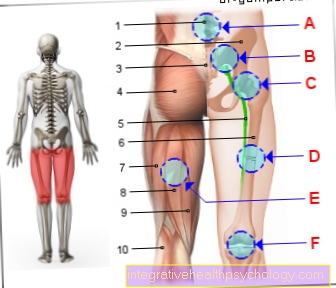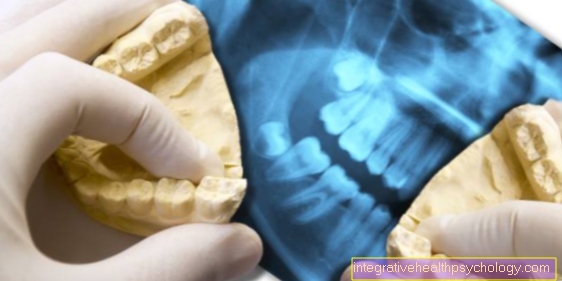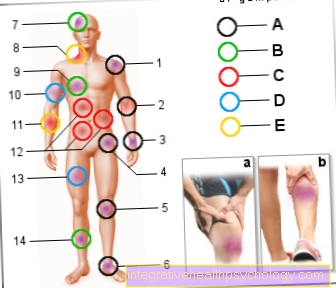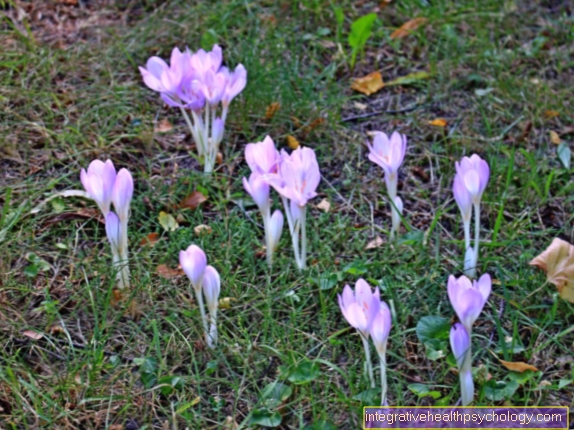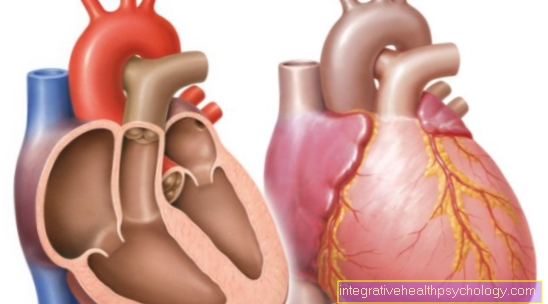Ointments and creams
introduction
There are numerous ointments and creams that you are sure to have in your household. But when is which ointment used? And what is the difference between an ointment, cream, lotion and gel?
We would then like to give you a brief overview of the most important preparations and in which cases they are used. Many of the preparations are available from pharmacies without a prescription, but you should read the package insert before using them and consult your doctor or pharmacist. In the case of severe or chronic skin diseases, including other symptoms, you should definitely consult a doctor and have the skin condition clarified.
Topical therapy, i.e. the application of topical therapeutic agents on the skin, is used particularly in the case of dermatological diseases, the skin diseases. The phase triangle is often used to explain the differences between the various preparations. Each corner of the triangle stands for one of the phases liquid, solid and fatty, the preparations each represent one of the connecting lines between the phases.

Creams

A cream is located in the phase triangle between fat and liquid, so these mixtures consist of proportions of fat and liquid. There are also water-based creams with a higher proportion of liquid and fat-based creams with a higher proportion of fat. Emulsifiers are added to creams to prevent the phases from separating. Creams should not be used on very dry skin as they can make the condition worse. They have a light consistency and are quickly absorbed, and water-based creams in particular have a cooling effect that has a calming effect on insect bites and allergic skin changes.
The most popular skin creams are discussed below as an overview.
Nivea®
This well-known cream is a real all-rounder. Nivea has different products for every skin type, they are very skin-friendly and caring. Nivea Creme can be used on the face as well as on other dry areas such as elbows or hands.
Penaten®
Penaten® Creme is a skin and wound protection cream and is particularly known from baby care.Thanks to its skin-friendly composition, it is particularly suitable for babies and adults with very sensitive skin.
Florena®
Florena Creme is also a beauty all-rounder. Different care series are suitable for the face care of different skin types. Florena is also very skin-friendly.
FeniHydrocort® cream
This is a cream for use in the case of moderate inflammatory skin diseases. It contains cortisone and so relieves signs of inflammation in the skin.
Hydrocortisone Cream
Like FeniHydrocort, there are cortisone-containing creams from various manufacturers for use in moderate inflammatory skin diseases. Some creams are especially suitable for use on contact eczema, sunburn or mosquito bites.
Finalgon® warming cream
The warming cream relieves tension, muscle and joint pain and is often used in the treatment of back pain.
More on this under: Finalgon
Vagisan® moisturizer
Vagisan® Moisturizing Cream is used for symptoms caused by vaginal dryness or the external genital area, such as burning, itching, injuries or pain during intercourse. A lack of estrogen after menopause is often the cause. The cream is applied in the vagina and on the skin of the genital area. The cream should only be used in the event of discomfort, a healthy vagina usually does not require any additional care measures.
Read more about this: Vagisan®
Anoint

An ointment is a preparation with a high fat content. The so-called pure fatty ointments are generally rarely used because they are less tolerated by patients. Ointments with a slightly higher proportion of water are absorbed more quickly. In general, ointments have a covering and greasy effect.
You will also find an overview of the most important ointments.
Ointments containing petroleum jelly
Vaseline is very versatile and well tolerated even by sensitive skin. It is suitable as a moisturizer, wound cream, cold protection and for muscle hardening and pain.
Paraffinic ointments
Many care products contain paraffin. Its mode of action is controversial, paraffin puts a film on the skin and is not absorbed by it. The user experiences soft and relaxed skin, but the pores of the skin clog and the skin's own regeneration mechanisms are disturbed. Long-term use can dry out the skin.
Waxy ointments
Wax ointments provide moisture, soothe and regenerate irritated, cracked, dry or sensitive skin. It also has a healing effect.
Zinc ointment
Zinc ointment is suitable for the treatment of pimples and acne and is used in wound treatment. It has an antiseptic and wound healing effect.
Pull ointment
This ointment is used for purulent skin inflammation, such as pimples or abscesses. It accelerates the maturation and emptying of abscesses and has anti-inflammatory and antibacterial effects.
Further information on this: Pull ointment
Clobetasol® ointment
Clobetasol ointment contains a strong corticosteroid and is used for therapy-resistant plaques in the context of inflammatory skin diseases such as psoriasis.
Ointment containing hydrocortisone
Ointments containing cortisone are used for the local treatment of moderately pronounced inflammatory skin diseases.
Read more on this topic at: Cortisone ointment
Kytta® pain ointment
This ointment contains comfrey root fluid extract and is a herbal alternative to ointments with the active ingredient diclofenac or other NSAIDS, i.e. pain relievers. It is used for muscle, joint and back pain.
Our article on this: Kytta® ointment
Horse ointment
Horse ointment is suitable for treating muscle tension and pain, as well as joint pain. It was originally developed for horses and is now mainly used in sports. It contains herbal ingredients such as menthol, rosemary, arnica and camphor. Horse ointment has a cooling, circulation-promoting, pain relieving and anti-inflammatory effect.
Also read our article: Horse ointment
Arnica ointment
Arnica ointment contains an extract from the arnica flower and is another herbal medicine for external use. Arnica is considered a natural pain reliever and can be used for anything from bruises and muscle pain to joint pain, such as arthritis.
Diclofenac ointment
Diclofenac is an active ingredient from the group of non-steroidal anti-inflammatory drugs (NSAIDS) and has an analgesic and anti-inflammatory effect. It is used for the external supportive treatment of pain in acute strains, bruises or sprains, for example as a result of sports accidents.
More on this: Diclofenac ointment
Lotions

Lotions are also a mixture of fat and liquid. The proportion of liquid is very high. They are used for acute dermatoses, such as sunburn, because they have a cooling effect on the skin. However, they can severely dry out the skin. With a lotion, it is worth paying attention to the ingredients it contains and using high-quality products. Effective and usually well-tolerated additives in lotions are, for example:
- Panthenol
- urea
- Lactic acid
- glycerin
- Hyaluronic acid
With the following additives you should watch out for symptoms of allergies. Some are also suspected of being carcinogenic or can damage the skin and body in other ways:
- Paraffin: clogs pores and disrupts the skin's natural regeneration mechanisms, as well as high environmental pollution due to this by-product from oil production
- Parabens, preservatives
- Polyethylene glycol
- can cause hypersensitivity reactions: emulsifiers, fragrances, lanolin (wool fat)
- Tea tree oil: Tea tree oil can lead to contact eczema, it also has a short shelf life and breaks down into aggressive turpentine
Gels

In contrast to ointments and creams, gels are completely fat-free. They are semi-solid, scientifically referred to as viscoelastic fluids. Gels are the basis of various drug preparations, they also have a cooling effect on the skin. Gels are also used in ultrasound examinations because they improve echogenicity by creating a cushion of fluid between the transducer and the skin.
A list of the most important gels can be found below.
Fenestil gel
Fenistil Gel contains the antihistamine Dimentinden, has a cooling effect and relieves itching. It is suitable for use on sunburns, minor burns or insect bites.
Our article on this: Fenestil gel
Diclofenac gel
Diclofenac is an active ingredient for relieving pain and inflammation and is used externally for muscle or joint pain, such as sports injuries such as strains, bruises and sprains.
Also read: Diclofenac gel
Contractubex® scar gel
The gel can be used to treat scars, for example after operations, cuts or acne scars and stretch marks. It is a combination of the active ingredients onion extract, heparin and allantoin which have anti-inflammatory, moisturizing and wound healing effects.
Read more on this topic: Contractubex®
Tyrosur gel
Tyrosur Gel is suitable for use on infected wounds. It can be used in every phase of wound healing, for oozing, open as well as closed and dry wounds. The active ingredient tyrothricin from the group of antibiotics has an antibacterial effect and fights pathogens that cause wound infections.
Further information
- Skin cream
- Cream against dark circles
- Anti-inflammatory cream
- Kaufmanns® skin and children's cream
- Tannolact fat cream
Exclusion of liability / disclaimer
We would like to point out that medication must never be discontinued, applied or changed independently without consulting your doctor.
Please note that we cannot claim that our texts are complete or correct. The information may be out of date due to current developments.

